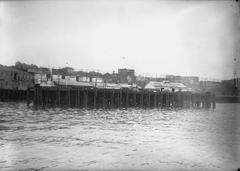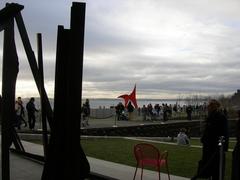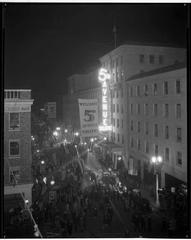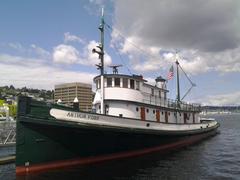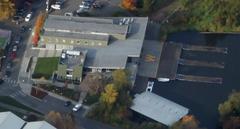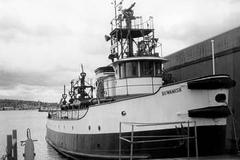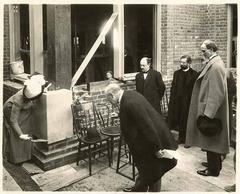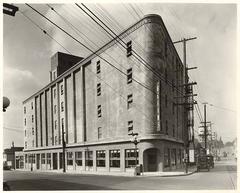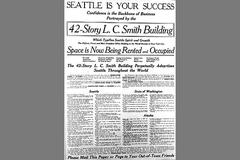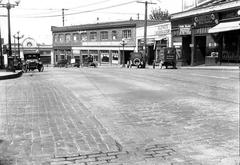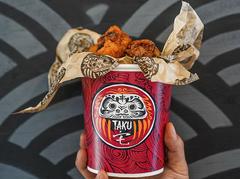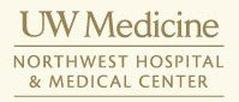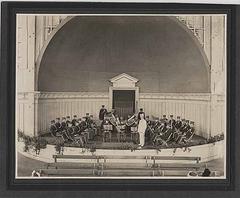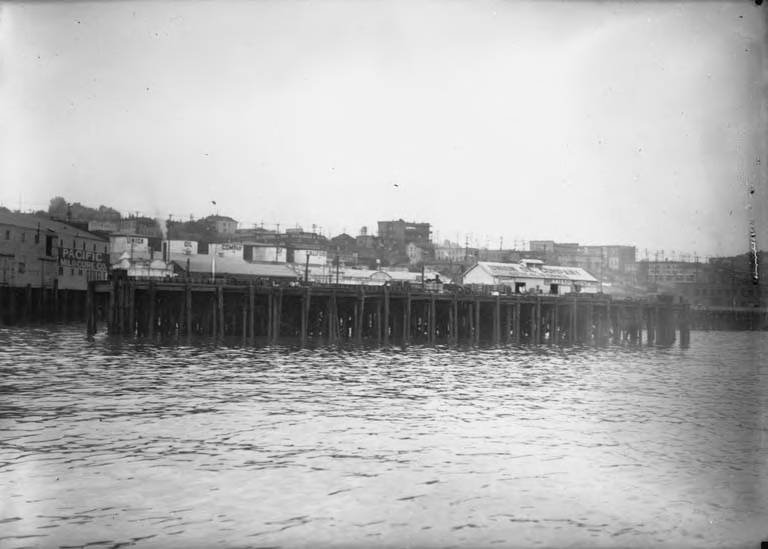
Olympic Sculpture Park Seattle: Visiting Hours, Tickets, and Complete Guide
Date: 14/06/2025
Introduction
Nestled along Seattle’s picturesque Elliott Bay, the Olympic Sculpture Park stands as a vibrant testament to the fusion of contemporary art, ecological restoration, and urban renewal. Operated by the Seattle Art Museum (SAM), this nine-acre park reclaimed a former industrial brownfield and transformed it into a celebrated public space that welcomes art lovers, nature enthusiasts, and community members alike. Designed by Weiss/Manfredi in collaboration with Charles Anderson Landscape Architecture and ORA Architects, the park’s innovative Z-shaped pathway connects downtown Seattle to the waterfront, weaving through four distinct Pacific Northwest ecosystems—valley, grove, meadow, and shore. Here, monumental sculptures by artists such as Alexander Calder, Richard Serra, and Jaume Plensa are thoughtfully integrated into restored natural landscapes (Seattle Art Museum, Weiss/Manfredi).
The Olympic Sculpture Park is open year-round with free admission, offering daily access to outdoor art, sweeping views of the Olympic Mountains and Puget Sound, educational programs, and community events. This comprehensive guide provides a detailed overview of the park’s history, visiting hours, accessibility, must-see artworks, environmental significance, and practical travel tips to ensure a memorable visit.
Historical Background and Site Transformation
From Industrial Brownfield to Urban Oasis
The land now home to the Olympic Sculpture Park was once dominated by oil transfer and storage operations, leaving behind significant soil contamination and environmental hazards. Officially classified as a brownfield, the site’s revitalization began with a vision from SAM trustees and support from local leaders and organizations such as The Trust for Public Land, which secured the land and initiated its transformation (Trust for Public Land). Environmental remediation included removing contaminated soil, restoring the shoreline, and installing rainwater management systems to support native flora and fauna (ORA Architects).
Design and Innovation
Weiss/Manfredi’s award-winning design reconnected fragmented urban parcels through a continuous green corridor, overcoming a 40-foot grade change and crossing over active train tracks and roads (Magnusson Klemencic Associates, ArchDaily). The park’s Z-shaped pathway creates four unique ecological environments—valley, grove, meadow, and shore—each providing a distinct setting for large-scale artworks.
Integrating Art and Environment
The Olympic Sculpture Park was conceived as a “landscape for art,” where permanent and rotating installations by world-renowned artists are harmoniously sited among native plantings and restored habitats (SAM Blog). The park’s design demonstrates how ecological restoration, sustainable urban development, and contemporary art can coexist and enhance public life.
Park Layout and Visitor Navigation
Z-Shaped Pathway and Ecosystems
The park’s signature Z-shaped pathway guides visitors from the city toward the waterfront, traversing four native Pacific Northwest ecosystems:
- Valley: Temperate evergreen forest with fir, cedar, hemlock, and ginkgo.
- Grove: Deciduous woodland with seasonally changing foliage.
- Meadow: Open grassy areas with native wildflowers.
- Shore: Restored beach and tidal garden supporting salmon habitat (Seattle Art Museum).
This layout supports stormwater management, wildlife corridors, and provides dramatic settings for the park’s signature artworks.
Accessibility and Amenities
The park features wide, gently sloping, wheelchair-accessible paths, benches, picnic areas, restrooms, water fountains, and bicycle parking. The PACCAR Pavilion at the park’s northeast corner houses visitor amenities and hosts indoor exhibitions and events (MyPacer).
Must-See Artworks and Installations
- Alexander Calder, The Eagle (1971): A vibrant 39-foot red steel sculpture, an iconic symbol of the park.
- Richard Serra, Wake (2004): Five towering steel plates creating an immersive walk-through experience.
- Jaume Plensa, Echo (2011): A monumental white sculpture of a girl’s head gazing over the bay.
- Claes Oldenburg & Coosje van Bruggen, Typewriter Eraser, Scale X (1999): A playful, oversized office tool.
- Mark Dion, Neukom Vivarium (2006): A living installation featuring a Western hemlock nurse log ecosystem.
- Louise Bourgeois, Eye Benches I, II, and III (1996–97): Granite benches shaped like giant eyes.
- Roxy Paine, Split (2003): A stainless steel tree sculpture.
- Teresita Fernández, Seattle Cloud Cover (2006): A glass bridge offering unique perspectives on the sky and landscape (Seattle Art Museum).
A complete list of works can be found on the Seattle Art Museum’s website.
Environmental Significance
The Olympic Sculpture Park is a national example of brownfield remediation and sustainable design (Landscape Performance). Key environmental features include:
- Shoreline Restoration: Creation of salmon habitat and tidal gardens reconnecting the urban core to Puget Sound.
- Rain Gardens & Native Plantings: Reduce stormwater runoff and support pollinators.
- Urban Wildlife Refuge: The park is home to birds, pollinators, and marine life, with stewardship programs supporting biodiversity (SAM Blog).
Visiting Information
Hours and Admission
- Hours: Open daily from 6:00 AM to 10:00 PM (some sources note opening 30 minutes before sunrise and closing 30 minutes after sunset—always check the official site for current hours).
- Admission: Free to all visitors. Donations are welcome.
Location and Directions
- Address: 2901 Western Avenue, Seattle, WA 98121.
- Getting There: Easily accessible by public transit (King County Metro buses, Seattle Streetcar), by bicycle (bike racks on-site), and by car (paid parking nearby).
Accessibility
- Physical Access: All main paths are wheelchair- and stroller-friendly, with accessible restrooms and seating areas.
- Service Animals: Welcome throughout the park.
Amenities
- PACCAR Pavilion: Indoor space for events and exhibitions.
- Restrooms: Available during pavilion hours.
- Drinking Water: Water fountains throughout the park.
- Picnic Areas: Benches and lawns for picnicking.
- Bike Parking: Provided on-site.
Guided Tours and Events
- Tours: Regular guided tours and educational programs offered by the Seattle Art Museum (Seattle Art Museum).
- Special Events: Seasonal concerts, family days, and community activities; check the SAM events calendar for details.
Visitor Experience Tips
- Dress for Seattle Weather: Wear layers and bring rain gear; summers are generally mild and dry.
- Respect the Art: Do not climb on or touch sculptures.
- Picnicking: Popular in summer—bring snacks and enjoy waterfront views.
- Photography: The park is a top spot for photos, especially during golden hour.
Nearby Attractions
- Pike Place Market: A 15-minute walk to Seattle’s iconic market.
- Space Needle & Museum of Pop Culture: A 20-minute walk or short ride.
- Myrtle Edwards Park: Adjacent waterfront trails and beach access.
- Seattle Art Museum (Downtown): Explore more art collections and exhibitions.
- Belltown & Downtown Seattle: Dining, shopping, and entertainment options abound.
Frequently Asked Questions (FAQ)
Q: What are the Olympic Sculpture Park visiting hours?
A: Generally 6:00 AM to 10:00 PM daily, but always confirm via the official site.
Q: Is there an admission fee or tickets required?
A: Admission is free; no tickets required.
Q: Is the park wheelchair accessible?
A: Yes, all main paths and facilities are accessible.
Q: Are pets allowed?
A: Yes, dogs are allowed but must be leashed.
Q: Are guided tours available?
A: Yes, regularly scheduled and bookable through the Seattle Art Museum.
Q: Where are restrooms and food available?
A: Restrooms are in the PACCAR Pavilion during open hours; food trucks may be present at events, with many dining options nearby.
Awards and Recognition
The park has received national awards including TIME magazine’s “10 Best Architectural Marvels” and the American Institute of Architects’ Honor Award (Magnusson Klemencic Associates), highlighting its innovative approach to urban redevelopment and public placemaking.
Virtual Experience and Online Resources
- Virtual Tours & Maps: Explore online via the Seattle Art Museum’s Olympic Sculpture Park page.
- Images & Accessibility: High-quality images with alt text (e.g., “Alexander Calder’s Eagle sculpture at Olympic Sculpture Park, Seattle”) are available to preview the park’s highlights.
Summary and Visiting Tips
Olympic Sculpture Park stands as a model for how contemporary art, environmental restoration, and urban access can revitalize city spaces. With its free admission, accessible design, and integration of monumental art within native ecosystems, the park is a cultural and ecological gem on Seattle’s waterfront. Combine your visit with nearby attractions for a full day of exploration.
For current events, tours, and visitor tips, see the Seattle Art Museum’s website and consider downloading the Audiala mobile app for curated audio tours and interactive guides.
Sources
- Trust for Public Land
- CityDays
- ArchDaily
- Seattle Art Museum Blog
- Weiss/Manfredi
- Landscape Performance
- SAM Blog
- Magnusson Klemencic Associates
